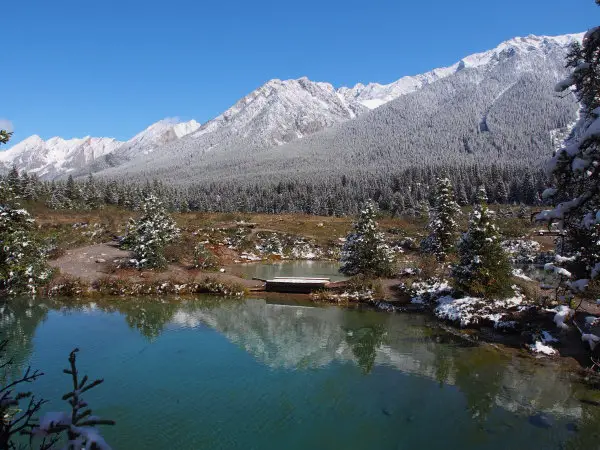Trout fishing can be particularly challenging during the winter months. As temperatures drop and conditions change, trout behavior and feeding patterns shift. While many fishermen find winter to be a miserable time to fish, due to cold temperatures, frozen guides and sluggish trout. Well, they are missing out, because on warm winter days the fishing can be spectacular.
Whether you fly, spin fishing or bait fish this guide will provide valuable insights and tips to help figure out what trout are most likely to be feeding upon over the winter months.
Surface – Winter Dry Fly Fishing
It is commonly quoted that trout feed from the surface only around 10% of the time. Well, over the winter months that percentage is even lower. Due to the lack of insect activity trout spend even less time surface feeding than during the summer.
It is only worthwhile throwing dry flies when you can actively see trout surface feeding.
In most of the country midges and the occasional blue wing olive mayfly (BWO) hatch make up the majority of winter food taken from the surface.
Both insects usually hatch during the warmest part of the day, which is usually between 10 am to 3 pm. BWO typically only hatch when the water temperature is above 38f but are much more likely in temperatures above 40. Midges are less temperature dependent and will hatch when their lifecycle dictates.
BWO are olive, to dark olive while the midges range from white to black. Their sizes range between #18#-#26, although due to ease of use, few fishermen will go smaller than a #24. When trout are surface feeding, it is generally better to fish smaller, rather than larger.
There are dozens of midge patterns, here are a few examples.
Midge flies
- Black Beauty
- Zebra Midge
- Griffiths Gnat
- Flashback Midge
Blue Wing Olive Flies
- Sparkle Dun
- Blue Winged Olive Parachute
Subsurface winter fishing
Fish eggs are an effective bait for winter trout.
During the colder months, few flies will out fish an egg pattern when targeting trout. This is because trout seem to home in on them as a food source, this even occurs in streams where no spawning takes place.
While trout will eat egg patterns year round, the colder months provide some of the best fishing opportunities. Egg patterns can be especially effective when fishing during the brown trout spawn, which occurs towards the end of fall and into early winter.
I personally prefer to fish unweighted egg patterns in sizes ranging from #12 to #16. Using unweighted eggs allows for a more natural drift through the water, resulting in more takes from hungry trout. However, to achieve a deep enough drift, it may be necessary to add some weight to the setup. A single piece of split shot placed a few inches above the egg can provide the added weight needed to get the egg down to the right depth.
Does color matter?
When fishing with egg patterns, it’s important to pay attention to the color of the eggs being used. I find that using a variety of colors can be effective, as different trout may be attracted to different hues. Popular colors include pink, chartreuse, and orange, although other colors can also be effective depending on the location and time of year.
How about egg size?
| Fish Species | Egg Size (mm) | Egg Size (in) |
|---|---|---|
| Chubb, Whitefish | 1-2 mm | 1/16-1/12 |
| Brown Trout, Rainbow Trout, Brook Trout, Cutthroat Trout | 3.5-4.5 mm | 1/8 |
| Large Rainbow Trout, Brown Trout, Cutthroat Trout, Steelhead Trout, Sockeye Salmon, Pink Salmon, Dolly Varden, Arctic Char | 6 mm | 1/4 |
| King Salmon, Large Steelhead Trout | 8 mm | 3/8 |
In my experience, a good drift is by far more important than having the correct size.
But, size is also an important consideration. When targeting trout during the trout spawn, I prefer to fish egg patterns ranging in size from #12-#14. These seem to do a good job at representing the size of the eggs floating through the water column. A general rule, is that the larger the trout, or fish that is spawning the larger their eggs will be. If fishing beneath spawning Salmon, I might be tempted to use a #10
So a stream brook char will have smaller eggs than a chinook salmon.
Sometimes it can be beneficial to vary the size of the egg pattern being used depending on the fishing conditions. During times of high water flow, larger egg patterns may be more effective, while smaller patterns may be better suited for low and clear water conditions.
Winter active mayfly nymphs
Just like their duns, trout will feed on BWO nymphs during the hatch. I find #14 to #22 to work well. Below I will give a few examples but any mayfly pattern should work including the classics.
- Barr’s emerger,
- Juju Baetis,
- Pheasant Tail
- Blue wing olive, CDC Emerger
Stone fly – Nymph hatches occur coast to coast and during their hatch, they can make up a significant portion of a trout’s diet. Winter stone flies are nearly always black. Hatches most commonly occur on bright sunny days with temperatures between 30-40f.
During the early winter months I typically fish stone flies in sizes between #18 – #20, Starting in late February larger species start to hatch that can be represented with flies between #10-#14
- Little Black Stonefly
Worms – Just like during the rest of the year, trout find it hard to resist a worm pattern that smacks them in their face.
Lure and spinner fishing for winter trout
Trout tend to be less aggressive feeders during the winter months. The type of fish that trout eat during winter can vary depending on the specific region and the availability of prey. However, in general, trout will feed on smaller fish, such as minnows, as well as aquatic insects and crustaceans like shrimp, crayfish.
The exact species of bait fish and crustaceans’ trout feed upon are really location dependent, trout are opportunistic feeders after all.
Some of the best trout fishing can be done during the spawning runs of various freshwater baitfish such as lake herrings.
Streamer fishing for winter trout
Winter is a great time to swing streamers. The brown trout are often hungry post spawn, and few are willing to give up a protein rich snack if it basically hits them in the face.
The key to success is to fish streamers low and slow but just as important is to keep moving, and cover as much water as possible.
Target slower water than during the summer which is about 3-4ft deep. A slow retrieve, slightly quicker than the current is usually ideal but do not be afraid to dead drift. Trout are less active than during the summer.
I generally prefer to fish streamers between #1-#6 in size, favoring larger streamers in bigger water. Although even in winter never be afraid to tie on something gigantic, winter seems to be the prime time to target large brown trout and at times a big streamer is the only thing that will trigger them.
With regard to patterns, I honestly do not think it matters much. Just fish whatever you have confidence in, and change colors with some frequency,
Spinning
The same tactics that prove successful for streamer fishing transfer over to the spinning rod.
Although, I find it is easier to fish even deeper spots.
When spinning over the winter months, I like lures that have plenty of action even at a slow retrieve. Some examples will include jointed Rapalas or flatfish lures. (Check my article here for more examples).
Cover plenty of water, and target trout holding near the bottom towards the head of a pool. Do not be afraid to use a little extra weight to get the lures down quicker.
For more in-depth tactics on winter fishing jerkbaits check my guide here.
How fast should lures and spinners be retrieved?
Water temperature dedicates the optimal retrieval speed. In icy conditions, when water temperature is below 40f (6c) slow down your presentation. The colder it is the slower the retrieve needs to be.
In slightly warmer winter waters, above 40f (6c) the trout remain active, and sometimes will even respond to a moderate-fast presentation. Even in ideal water conditions, trout rarely respond well to extremely fast retrieves.
This section is less relevant for winter fishing, but as water warms above 68f (20c) trout become sluggish due to the decline of available oxygen in the water, this again requires slower presentations.
How deep to fish during the winter months?
Trout often hold deeper in the winter months compared with summer, the most consistent fishing seems to be close to the bottom in water between 3-4ft.
It is important to get the flies down deep and allow the current to give them a natural drift while minimizing drag.
In still water, trout can hold even deeper. They often prefer the shallows, even as little as a couple of feet. When in the shallow flats, the trout typically stick close to the bottom.
At other times, they gather in deeper water down to around 15ft in depth. In these deeper spots, do not expect the trout to be holding tight to the bottom, but they either work the drop-offs or suspend the mid-water column.
Where to find trout in winter?
Trout will congregate in slow flowing pools over three feet in depth. Winter is a very lean time of year, so they are even more likely to seek out structures such as submerged logs or large boulders to shelter behind.
Even in winter, trout prefer water with a little current. That is because they want the food to come to them, rather than having to use energy to chase it down.
Trout seat low in their pools, because the water is ever so slightly warmer at depths. This is usually because the influence of great water swelling up is greater. Spring flows are warmer than surface water.
This brings me to the final place to find trout, which is around spring eruption zones, or even in spring fed streams. As I mentioned above, spring water is warmer. So the trout seek it out.
For more advice on where to find trout over winter, check my guide here.


